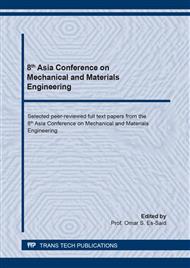p.25
p.30
p.36
p.45
p.51
p.57
p.64
p.70
p.76
Microscopic Damage Model for Fibrous Composites Considering Randomness in Constituent Materials
Abstract:
For the multiscale damage behaviour simulation of advanced materials with hierarchical and random heterogeneous microstructures such as fibrous composites by finite element method, the mathematical homogenization method has been extended to the stochastic nonlinear multiscale method. A first-order perturbation based stochastic homogenization method was developed to calculate the microscopic strain, as well as the homogenized macroscopic properties considering randomness in the mechanical properties of constituent materials. Based on the calculated stochastic microscopic strain, the damage simulation framework was proposed for fibrous composites. For a demonstrated application, a numerical example of a single short fiber reinforced plastic composite was carried out. The damage propagation in the interphase between fiber and matrix was predicted in a stochastic way considering the physical random parameters for the interphase material model. The influences of the randomness on damage volume fraction and damage propagation of the interphase were discussed.
Info:
Periodical:
Pages:
51-56
Citation:
Online since:
November 2020
Price:
Сopyright:
© 2020 Trans Tech Publications Ltd. All Rights Reserved
Share:
Citation:


